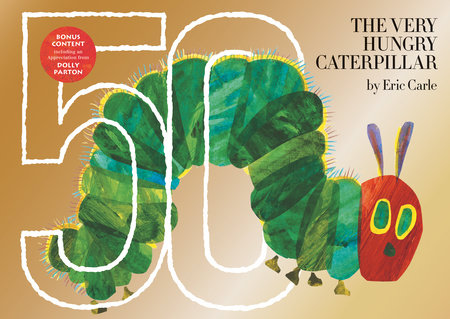A Timeless Tale of Transformation: Celebrating 50 Years of The Very Hungry Caterpillar
by Charnaie Gordon
The story begins on a moonlit night, with a tiny egg on a bright green leaf. The next morning, a red-faced caterpillar pops out. Famished, he eats his way through a watermelon, an ice cream cone, a slice of Swiss cheese, some salami, and a whole feast of foods until he isn’t a little caterpillar anymore. And he definitely isn’t hungry.
I’m sure you know what happens next. Many of you can probably recite it from memory, having read it countless times over. That newly big, fat caterpillar spins himself a cocoon and stays there until the magical moment when he re-emerges as a beautiful butterfly.
You’ve probably guessed that I’m talking about The Very Hungry Caterpillar by Eric Carle.
It’s no wonder this timeless classic — published in 1969 — has captured the hearts of little readers everywhere for the past fifty years. It was certainly one of my childhood favorites and I’ve loved revisiting it as an adult while reading it with my own children. I have such fond memories of both kids sitting on my lap, pointing at the bright illustrations and poking their tiny baby fingers into those iconic die-cut holes throughout the book. Thinking back to those memories, I’m reminded that in many ways the caterpillar is a lot like the babies and toddlers so enthralled by him: new to the world, insatiably hungry, constantly growing, discovering, and developing into something wonderful.
Beyond answering the question of where butterflies come from, this enchanting book helped me give my children lessons in counting and an early introduction to discussing healthy (and not so healthy) foods. It also helped me teach my kids about sequencing, (the seven days of the week), identifying opposites, and repetition. One of my favorite things is how seamlessly Carle integrates various subject matters into the story: science, math, art, language — and even thematic matters like hope and transformation.
I’d be remiss if I didn’t mention the physicality of this book. Who can resist a beautiful board book with brilliant and tactile illustrations? For kids and parents alike, that final image of a beautiful, vibrantly colored butterfly is pure joy. My family’s copy of The Very Hungry Caterpillar is worn and ripped, which also translates to well-loved and adored. I would venture a guess that one of the reasons Carle’s books remain popular is his ability to capture an audience, draw engaging illustrations, and — of course — tell great stories.
During my childhood, the caterpillar subtly taught me an important lesson that’s stayed with me into my adult life, and in some ways preserved the magic of childhood: transformation is possible and exciting changes are on the horizon. This is a message I hope my children carry with them as they continue growing, discovering, and developing into their own radiant, wonderful selves.

